
Timing & Time Perception
Scope & Guideline
Innovating Research on Time and Its Perception
Introduction
Aims and Scopes
- Interdisciplinary Exploration of Time:
The journal emphasizes the integration of perspectives from neuroscience, psychology, physics, and philosophy to create a comprehensive understanding of time perception. - Cognitive and Psychological Aspects of Time:
Research focuses on how humans perceive, estimate, and experience time, including the cognitive mechanisms underlying temporal judgments. - Neuroscience of Time Perception:
The journal publishes studies investigating the neural correlates of time perception, including how timing is represented in the brain and its implications for behavior and cognition. - Temporal Dynamics in Various Contexts:
Topics include how time perception varies across different contexts, such as during emotional experiences, age-related changes, and situational factors. - Theoretical Contributions on Time:
Contributions that propose new theories or challenge existing paradigms regarding the nature and perception of time are a key focus.
Trending and Emerging
- Integration of Neuroscience and Psychology:
There is a growing trend towards combining neuroscience with psychological concepts to explore how temporal perception is influenced by neural mechanisms and cognitive processes. - Impact of Socio-Economic Factors on Time Perception:
Research increasingly examines how socio-economic conditions, such as those highlighted during the COVID-19 pandemic, affect individuals' perceptions of time and well-being. - Temporal Dynamics in Virtual Environments:
Studies focusing on time perception in virtual reality settings are emerging, reflecting advancements in technology and their implications for understanding cognitive processes. - Temporal Perspective and Personal Well-Being:
An increasing number of articles are exploring the relationship between time perspective and psychological well-being, emphasizing the importance of how individuals perceive their past, present, and future. - Causation and Time Perception:
A new focus on the role of causation in temporal judgments indicates a deeper investigation into how people relate events over time and how this affects their perception of time.
Declining or Waning
- Traditional Temporal Measurement Techniques:
There has been a noticeable decline in studies focusing on classical methods of measuring time perception, suggesting a movement towards more innovative and interdisciplinary approaches. - Basic Temporal Illusions:
Research on simple temporal illusions has waned, indicating a shift towards more complex phenomena involving cognitive and emotional factors in time perception. - Age-Related Time Perception Studies:
Although age-related differences in time perception were once a significant focus, recent publications have shown a decreased emphasis on this area, possibly due to the growing interest in broader psychological and contextual influences. - Cultural Studies of Time Perception:
Investigations into how time perception varies across different cultures have become less frequent, as the journal's emphasis shifts towards more universal cognitive and biological aspects. - Static Models of Time Perception:
There is a decline in the publication of static models that do not account for the dynamic nature of time perception influenced by various factors such as attention or emotional states.
Similar Journals
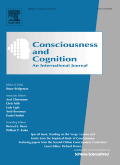
CONSCIOUSNESS AND COGNITION
Illuminating the Intricacies of CognitionConsciousness and Cognition is a prestigious academic journal dedicated to advancing the understanding of cognitive processes and consciousness. Published by Academic Press Inc, Elsevier Science, the journal has maintained a prominent presence in the field since its inception in 1992, reaching a converged publication timeline through 2024. With an impact factor reflecting its high relevance, it holds a Q1 rank in Arts and Humanities and Q2 ranks in both Developmental and Educational Psychology and Experimental and Cognitive Psychology as of 2023. Researchers and academics utilize this journal as a critical resource for the latest empirical findings, theoretical advancements, and innovative methodologies in understanding the intricacies of human cognition and conscious experience. Although it does not offer open access, the journal’s extensive contributions help shape active dialogues within this interdisciplinary domain, making it essential reading for professionals, researchers, and students alike striving to explore the mysteries of consciousness.
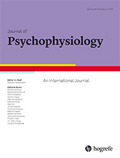
JOURNAL OF PSYCHOPHYSIOLOGY
Transforming Research into Real-World ApplicationsJOURNAL OF PSYCHOPHYSIOLOGY, published by Hogrefe Publishing Corp, serves as a crucial platform for the dissemination of research in the interdisciplinary fields of neuropsychology, physiological psychology, and neuroscience. With an ISSN of 0269-8803 and an E-ISSN of 2151-2124, this journal has been a staple in the academic community since its inception in 1987 and will continue to publish impactful research until at least 2024. Despite the absence of Open Access, the journal maintains a significant presence, holding Q3 and Q4 quartile rankings in relevant disciplines according to the 2023 metrics. Researchers and practitioners benefit from the journal's robust focus on integrating psychophysiological research with practical applications, contributing to a better understanding of psychological processes through physiological insights. As evident from its Scopus rankings, the JOURNAL OF PSYCHOPHYSIOLOGY is dedicated to fostering scholarly dialogue and advancing knowledge in the field, making it an essential resource for anyone invested in the intricacies of human behavior and the physiological underpinnings thereof.
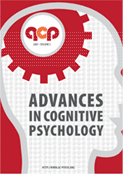
Advances in Cognitive Psychology
Empowering Minds Through Innovative ResearchAdvances in Cognitive Psychology is a premier peer-reviewed journal published by UNIV ECONOMICS & HUMAN SCIENCES WARSAW, dedicated to the exploration of psychological processes underlying cognition. With its open access model implemented since 2005, the journal facilitates wide-ranging dissemination of cutting-edge research across various branches of psychology, including applied, clinical, experimental, and cognitive psychology. Despite its modest standing in terms of impact factor, reflected in its Q3 and Q4 rankings across numerous subfields, it remains an important platform for emerging researchers and seasoned professionals alike, aiming to foster insight into complex mental processes and enhance understanding of behavioral patterns. The journal's commitment to accessibility empowers a diverse community of readers, including students, to engage with innovative studies and reviews, contributing to the collective knowledge within the psychological sciences. Located in Poland, Advances in Cognitive Psychology is open for submissions from worldwide researchers, encouraging a global perspective on cognition and behavior.
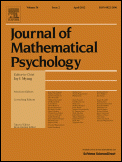
JOURNAL OF MATHEMATICAL PSYCHOLOGY
Transforming Psychological Inquiry through Mathematical RigorJOURNAL OF MATHEMATICAL PSYCHOLOGY, published by Academic Press Inc Elsevier Science, is a premier scholarly journal dedicated to advancing the intersection of mathematics and psychology through rigorous research and innovative methodologies. Since its inception in 1964, this esteemed publication has charted significant developments in both Applied Mathematics and Psychology, consistently ranking in the top quartile (Q1) of its categories as of 2023. With a focus on the application of mathematical techniques to psychological problems, the journal serves as a pivotal resource for researchers and professionals alike, providing insights that enhance understanding of cognitive processes and behavioral phenomena. Researchers can access a wealth of articles that reflect the latest trends and inquiries in the field, making this journal an essential tool for advancing academic and professional literacy. The JOURNAL OF MATHEMATICAL PSYCHOLOGY promotes a collaborative dialogue across disciplines, fostering a deeper comprehension of the intricate relationship between quantitative analysis and human behavior.

PALEONTOLOGICAL JOURNAL
Unearthing the Past, Shaping the Future.The PALEONTOLOGICAL JOURNAL, published by PLEIADES PUBLISHING INC, is a premier platform for the dissemination of research in the field of paleontology. With an ISSN of 0031-0301 and E-ISSN 1555-6174, this journal serves the academic community by providing insights into fossil studies, evolutionary biology, and the historical narrative of life on Earth. Despite being categorized in the Q3 quartile for 2023 and currently holding a Scopus rank of #84 out of 113 in the Earth and Planetary Sciences- Paleontology category, it remains a valuable resource for researchers and practitioners. The journal's coverage spans from 1990 to 2024, offering a comprehensive historical perspective while also addressing contemporary issues in paleological research. Scholars and students alike benefit from its rigorous peer-reviewed articles and the opportunity to access vital knowledge in the ever-evolving field of paleontology.
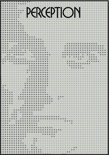
PERCEPTION
Championing Rigorous Research in Perceptual SciencePERCEPTION is a leading journal published by SAGE PUBLICATIONS LTD, focusing on the multidisciplinary aspects of perception across various fields, including Artificial Intelligence, Experimental and Cognitive Psychology, Ophthalmology, and Sensory Systems. With a commitment to advancing knowledge and fostering innovative research, the journal has been in circulation since 1972 and is recognized for its rigorous peer-review process and significant contributions to the academic community. Its current impact factor and Scopus rankings position it within the esteemed Q2 and Q3 categories, making it a valuable resource for researchers and professionals aiming to explore the complexities of human perception and its computational models. Although PERCEPTION does not offer open access, it provides essential insights and findings that are particularly relevant for students and academics in psychology, neuroscience, and artificial intelligence. Addressing cutting-edge topics, this journal serves as a vital forum for the exchange of research ideas and methodologies in the evolving landscape of perception studies, making it a crucial asset for anyone dedicated to understanding this intricate field.

PSYCHOLOGIA
Fostering Scholarly Dialogue in PsychologyPSYCHOLOGIA is a distinguished academic journal published by the Psychologia Editorial Office, focusing on the broad field of psychology. Originating from Japan, the journal serves as a platform for innovative research and insights into various psychological phenomena, contributing significantly to the advancement of psychological knowledge since its establishment in 1996. With an ISSN of 0033-2852 and an E-ISSN of 1347-5916, PSYCHOLOGIA primarily targets researchers, professionals, and students who are passionate about the intricacies of human behavior and cognition. Currently categorized in the Q4 quartile of psychology (miscellaneous) based on 2023 metrics, it holds a Scopus rank of #157 out of 216, indicating its developing presence within the academic community. Despite being published without open access options, the journal remains committed to fostering scholarly dialogue and disseminating significant findings that shape contemporary psychological research. As it converges towards its issue set for 2024, PSYCHOLOGIA continues to be an essential resource for those seeking to deepen their understanding of psychological sciences.

Dialog so Vremenem-Dialogue with Time
Fostering Insightful Exchanges on Time's InfluenceDialog so Vremenem - Dialogue with Time is a prestigious academic journal published by the Russian Society for Intellectual History, focusing on the intricate interplay between historical narratives and philosophical thought. With its ISSN 2073-7564, the journal has established a significant presence in the scholarly community since its inception in 2016. It is categorized in the Q2 quartile for History and Q3 for Philosophy, reflective of its critical engagement with intellectual heritage and contemporary issues. Although not currently an open-access journal, it aims to provide valuable insights into the evolution of thought across different epochs, making it an essential resource for researchers, professionals, and students alike. The journal's contributions are recognized within Scopus, ranking at a notable percentile, which underscores its relevance and impact in the fields of Arts and Humanities. With its ongoing commitment to fostering dialogue in intellectual history, Dialog so Vremenem remains a vital platform for scholarly exchange and exploration of time’s influence on ideas.

MUSIC PERCEPTION
Exploring the Soundscape of Human ExperienceMUSIC PERCEPTION is a prestigious academic journal dedicated to the interdisciplinary exploration of musical experience and understanding. Published by the University of California Press, this journal has established itself as an essential resource in the field of music psychology, with a strong emphasis on how auditory stimuli influence human cognition and emotion. The journal boasts a commendable Q1 ranking in Music, placing it within the top-tier of scholarly publications, and it holds an impressive Scopus Rank of #4 out of 180 in the Arts and Humanities category, reflecting its critical role in advancing research within this domain. MUSIC PERCEPTION welcomes contributions that delve into diverse topics, including auditory perception, acoustics, and the psychological impacts of music, making it a vital platform for researchers, professionals, and students seeking to deepen their understanding of music's multifaceted nature. The journal is published annually and remains a cornerstone for academic discourse, ensuring that new findings are readily accessible to a global audience.

KronoScope-Journal for the Study of Time
Advancing Knowledge in the Philosophy and Science of TimeKronoScope: Journal for the Study of Time, published by BRILL, is an interdisciplinary journal that delves into the complexities and philosophical inquiries surrounding the concept of time. With an ISSN of 1567-715X and E-ISSN 1568-5241, this journal has been a pivotal outlet for scholarly research since its inception in 2001, converging invaluable insights from fields such as Astronomy, History and Philosophy of Science, Philosophy, and Social Sciences. Despite a current categorization in Q4 and Q3 quartiles in various fields, KronoScope allows for diverse and nuanced discussions that encourage academic engagement and exploration. Positioned within the Netherlands and accessible globally, it aims to foster an open dialogue among researchers, professionals, and students alike, urging them to investigate the multifaceted nature of time as a central theme across disciplines. If you're seeking to contribute or engage with contemporary discourse in this fascinating field, KronoScope offers a unique platform dedicated to elevating scholarly understanding.